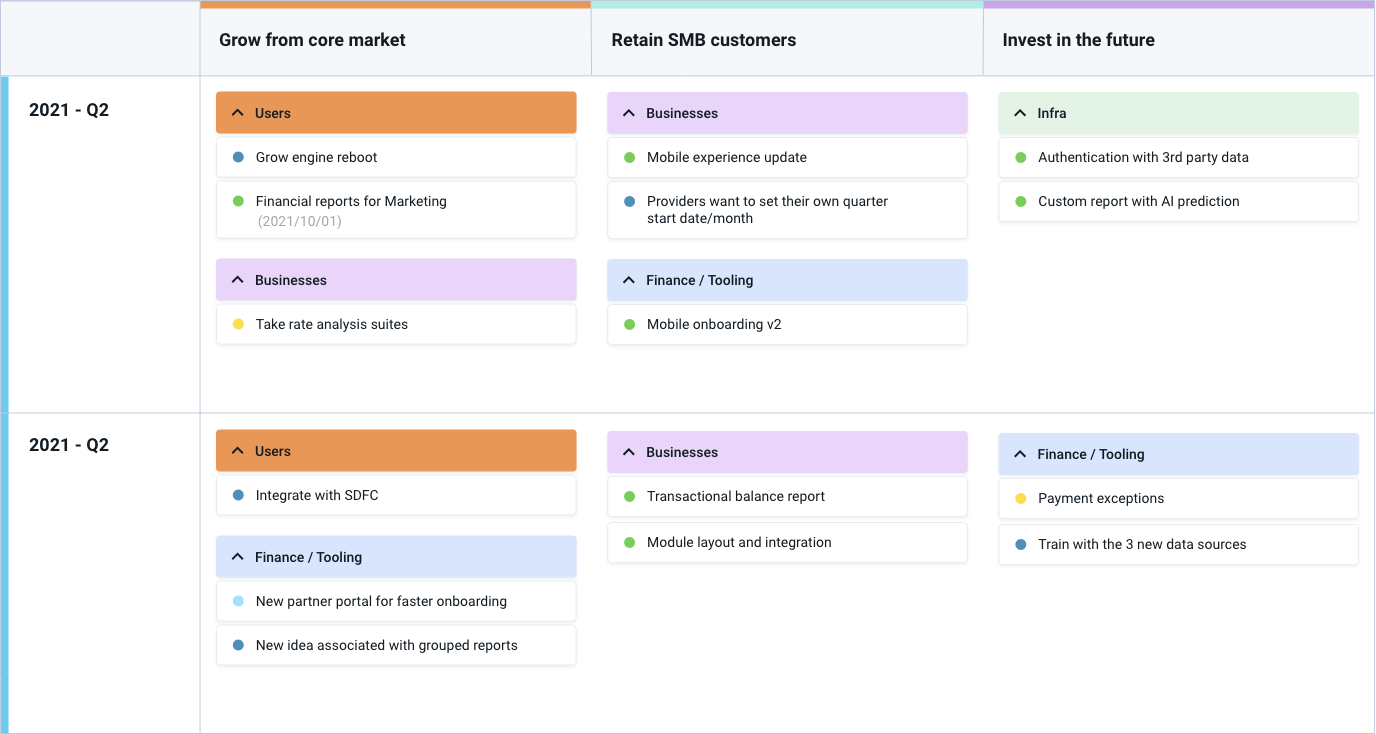Outcome Roadmap: Aligning Product Initiatives with Strategic Goals
An outcome roadmap is a forward-looking planning framework designed to align product development efforts with key business goals. Instead of focusing on feature delivery, this approach prioritizes measurable outcomes, ensuring that every initiative contributes to overarching company objectives. By shifting the focus from outputs to impact, outcome roadmaps help teams make data-driven decisions, adapt to evolving market needs, and drive meaningful business growth.
Key Components of an Outcome Roadmap
- Defined Outcomes: Clearly articulated goals that the product aims to achieve, ensuring alignment with the organization’s strategic vision.
- Strategic Alignment: Initiatives are selected based on their potential to contribute to these defined outcomes, ensuring that all efforts support the overarching business objectives.
- Continuous Evaluation: Regular assessment of progress toward outcomes, allowing for adjustments and iterative improvements based on real-time feedback and data.
Benefits of Implementing an Outcome Roadmap
- Enhanced Focus: Prioritizes initiatives that directly impact key business goals, eliminating unnecessary features that do not add value.
- Improved Collaboration: Aligns cross-functional teams around shared objectives, fostering better communication and teamwork.
- Measurable Success: Establishes clear metrics for success, enabling teams to track progress and demonstrate the value of their work.
How Do Outcome Roadmaps Differ from Feature Roadmaps?
Traditional feature roadmaps focus on maintaining a backlog of ideas based on customer feedback, market insights, and internal suggestions. While having a prioritized backlog may seem like a best practice, it inherently assumes a fixed prioritization framework that does not evolve with changing business goals or market conditions.
An outcome roadmap, on the other hand, is dynamic and adjusts priorities based on evolving business objectives and customer needs. Instead of predefining what features to build, outcome roadmaps start at a higher strategic level—aligning product initiatives with overarching company goals rather than committing to specific deliverables.
Outcome-driven roadmaps shift the focus from shipping features to solving problems, ensuring that product development efforts remain relevant as market dynamics change.
Why Companies are Moving Away from Feature-Based Roadmaps
Product-led organizations are abandoning feature-first planning because it often leads to incremental improvements rather than true innovation—akin to building a “faster horse” rather than reinventing the market. Instead, they are embracing outcome-focused roadmaps, which enable responsive product portfolio management by continuously realigning efforts with business priorities.
Learn more about making the switch from feature to outcome roadmaps.
Building an Outcome Roadmap
Transitioning to an outcome-based roadmap involves a shift from a feature-centric mindset to one that prioritizes strategic goals. This approach requires defining clear objectives, aligning initiatives to these goals, and continuously evaluating progress.
Below are the key steps involved in building an outcome roadmap:
- Set goals and key strategies: Begin by establishing high-level Objectives and Key Results (OKRs) that align with the company’s vision. These goals serve as the foundation for developing strategies to achieve desired outcomes.
- Define metrics to measure goals: Identify specific metrics to evaluate the effectiveness of your initiatives. Clear metrics provide a benchmark for success and facilitate continuous improvement.
- Prioritize the most impactful features and initiatives: Align your ideas, requests, and initiatives with the defined goals. Prioritize them based on their potential impact, focusing on addressing critical problems first to avoid getting caught in the build trap. Utilizing prioritization frameworks, such as Metrics over Available Resources (MoAR) or RICE (Reach, Impact, Confidence, Effort), can aid in making informed decisions that drive desired outcomes. For more on Dragonboat’s approach to prioritization, read “Rock, Pebble, and Sand Product and Portfolio Management.”
- Allocate resources and plan for dependencies: To achieve the best portfolio outcomes, you must allocate resources towards short-term and long-term goals to ensure your company is not only achieving current goals but also growing and innovating towards future success.
- Monitor delivery progress: Once you have set your goals, strategic themes, prioritization, and resourcing, monitor delivery progress from engineering tools for real-time insights.
- Monitor outcome progress and adjust your roadmap based on results: Not only is it important to track the progress of product roadmap items (initiatives), but you should also track the progress of your OKRs (outcomes) to understand what worked and what didn’t to inform future product planning.
By following these steps, product teams can develop outcome-based roadmaps that not only align with strategic objectives but also deliver measurable value to both the business and its customers.
For a comprehensive guide on adopting this methodology, consider exploring How to Create Outcome-Based Roadmaps.

Conclusion
Building an outcome roadmap empowers organizations to move beyond feature-driven development and focus on delivering real business and customer impact. By aligning product initiatives with strategic goals, teams can drive innovation, optimize resources, and ensure long-term success. This approach fosters continuous improvement, adaptability to market shifts, and cross-functional collaboration, ultimately leading to better decision-making and sustained business growth.
For further insights into outcome-driven product management and its benefits, explore What is Outcome-Driven Product Management.